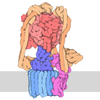[English] 日本語
 Yorodumi
Yorodumi- PDB-9bra: Intact V-ATPase State 2 and synaptophysin complex in mouse brain ... -
+ Open data
Open data
- Basic information
Basic information
| Entry | Database: PDB / ID: 9bra | |||||||||
|---|---|---|---|---|---|---|---|---|---|---|
| Title | Intact V-ATPase State 2 and synaptophysin complex in mouse brain isolated synaptic vesicles | |||||||||
 Components Components |
| |||||||||
 Keywords Keywords | MEMBRANE PROTEIN / V-ATPase / synaptic vesicle | |||||||||
| Function / homology |  Function and homology information Function and homology informationIon channel transport / regulation of opioid receptor signaling pathway / Amino acids regulate mTORC1 / clathrin-sculpted glutamate transport vesicle membrane / Transferrin endocytosis and recycling / Insulin receptor recycling / Metabolism of Angiotensinogen to Angiotensins / eye pigmentation / central nervous system maturation / rostrocaudal neural tube patterning ...Ion channel transport / regulation of opioid receptor signaling pathway / Amino acids regulate mTORC1 / clathrin-sculpted glutamate transport vesicle membrane / Transferrin endocytosis and recycling / Insulin receptor recycling / Metabolism of Angiotensinogen to Angiotensins / eye pigmentation / central nervous system maturation / rostrocaudal neural tube patterning / proton-transporting V-type ATPase, V1 domain / ROS and RNS production in phagocytes / positive regulation of transforming growth factor beta1 production / RHOA GTPase cycle / synaptic vesicle lumen acidification / P-type proton-exporting transporter activity / regulation of synaptic vesicle priming / proton-transporting V-type ATPase, V0 domain / extrinsic component of synaptic vesicle membrane / cellular response to increased oxygen levels / vacuolar proton-transporting V-type ATPase, V1 domain / vacuolar proton-transporting V-type ATPase, V0 domain / endosome to plasma membrane protein transport / clathrin-coated vesicle membrane / lysosomal lumen acidification / endosomal lumen acidification / proton-transporting V-type ATPase complex / head morphogenesis / protein localization to cilium / vacuolar proton-transporting V-type ATPase complex / osteoclast development / neuron projection terminus / regulation of short-term neuronal synaptic plasticity / vacuolar acidification / dendritic spine membrane / presynaptic active zone / syntaxin-1 binding / cholesterol binding / ATPase complex / microvillus / ATPase activator activity / regulation of MAPK cascade / autophagosome membrane / excitatory synapse / cilium assembly / proton-transporting ATPase activity, rotational mechanism / regulation of macroautophagy / positive regulation of Wnt signaling pathway / transporter activator activity / ATP metabolic process / H+-transporting two-sector ATPase / angiotensin maturation / ruffle / receptor-mediated endocytosis of virus by host cell / Neutrophil degranulation / axon terminus / endomembrane system / endoplasmic reticulum-Golgi intermediate compartment membrane / RNA endonuclease activity / proton transmembrane transport / receptor-mediated endocytosis / SH2 domain binding / secretory granule / neuromuscular junction / regulation of long-term neuronal synaptic plasticity / modulation of chemical synaptic transmission / small GTPase binding / Schaffer collateral - CA1 synapse / endocytosis / terminal bouton / apical part of cell / synaptic vesicle / synaptic vesicle membrane / melanosome / positive regulation of canonical Wnt signaling pathway / myelin sheath / signaling receptor activity / presynapse / ATPase binding / presynaptic membrane / chemical synaptic transmission / Hydrolases; Acting on ester bonds / intracellular iron ion homeostasis / postsynaptic membrane / early endosome / lysosome / endosome / neuron projection / endosome membrane / nuclear speck / cilium / apical plasma membrane / axon / lysosomal membrane / external side of plasma membrane / ubiquitin protein ligase binding / synapse / centrosome / endoplasmic reticulum membrane / protein-containing complex binding Similarity search - Function | |||||||||
| Biological species |  | |||||||||
| Method | ELECTRON MICROSCOPY / single particle reconstruction / cryo EM / Resolution: 4.3 Å | |||||||||
 Authors Authors | Wang, C. / Jiang, W. / Yang, K. / Wang, X. / Guo, Q. / Brunger, A.T. | |||||||||
| Funding support |  United States, 2items United States, 2items
| |||||||||
 Citation Citation |  Journal: Nature / Year: 2024 Journal: Nature / Year: 2024Title: Structure and topography of the synaptic V-ATPase-synaptophysin complex. Authors: Chuchu Wang / Wenhong Jiang / Jeremy Leitz / Kailu Yang / Luis Esquivies / Xing Wang / Xiaotao Shen / Richard G Held / Daniel J Adams / Tamara Basta / Lucas Hampton / Ruiqi Jian / Lihua ...Authors: Chuchu Wang / Wenhong Jiang / Jeremy Leitz / Kailu Yang / Luis Esquivies / Xing Wang / Xiaotao Shen / Richard G Held / Daniel J Adams / Tamara Basta / Lucas Hampton / Ruiqi Jian / Lihua Jiang / Michael H B Stowell / Wolfgang Baumeister / Qiang Guo / Axel T Brunger /     Abstract: Synaptic vesicles are organelles with a precisely defined protein and lipid composition, yet the molecular mechanisms for the biogenesis of synaptic vesicles are mainly unknown. Here we discovered a ...Synaptic vesicles are organelles with a precisely defined protein and lipid composition, yet the molecular mechanisms for the biogenesis of synaptic vesicles are mainly unknown. Here we discovered a well-defined interface between the synaptic vesicle V-ATPase and synaptophysin by in situ cryo-electron tomography and single-particle cryo-electron microscopy of functional synaptic vesicles isolated from mouse brains. The synaptic vesicle V-ATPase is an ATP-dependent proton pump that establishes the proton gradient across the synaptic vesicle, which in turn drives the uptake of neurotransmitters. Synaptophysin and its paralogues synaptoporin and synaptogyrin belong to a family of abundant synaptic vesicle proteins whose function is still unclear. We performed structural and functional studies of synaptophysin-knockout mice, confirming the identity of synaptophysin as an interaction partner with the V-ATPase. Although there is little change in the conformation of the V-ATPase upon interaction with synaptophysin, the presence of synaptophysin in synaptic vesicles profoundly affects the copy number of V-ATPases. This effect on the topography of synaptic vesicles suggests that synaptophysin assists in their biogenesis. In support of this model, we observed that synaptophysin-knockout mice exhibit severe seizure susceptibility, suggesting an imbalance of neurotransmitter release as a physiological consequence of the absence of synaptophysin. | |||||||||
| History |
|
- Structure visualization
Structure visualization
| Structure viewer | Molecule:  Molmil Molmil Jmol/JSmol Jmol/JSmol |
|---|
- Downloads & links
Downloads & links
- Download
Download
| PDBx/mmCIF format |  9bra.cif.gz 9bra.cif.gz | 1.4 MB | Display |  PDBx/mmCIF format PDBx/mmCIF format |
|---|---|---|---|---|
| PDB format |  pdb9bra.ent.gz pdb9bra.ent.gz | Display |  PDB format PDB format | |
| PDBx/mmJSON format |  9bra.json.gz 9bra.json.gz | Tree view |  PDBx/mmJSON format PDBx/mmJSON format | |
| Others |  Other downloads Other downloads |
-Validation report
| Summary document |  9bra_validation.pdf.gz 9bra_validation.pdf.gz | 1.7 MB | Display |  wwPDB validaton report wwPDB validaton report |
|---|---|---|---|---|
| Full document |  9bra_full_validation.pdf.gz 9bra_full_validation.pdf.gz | 1.7 MB | Display | |
| Data in XML |  9bra_validation.xml.gz 9bra_validation.xml.gz | 196.2 KB | Display | |
| Data in CIF |  9bra_validation.cif.gz 9bra_validation.cif.gz | 310.1 KB | Display | |
| Arichive directory |  https://data.pdbj.org/pub/pdb/validation_reports/br/9bra https://data.pdbj.org/pub/pdb/validation_reports/br/9bra ftp://data.pdbj.org/pub/pdb/validation_reports/br/9bra ftp://data.pdbj.org/pub/pdb/validation_reports/br/9bra | HTTPS FTP |
-Related structure data
| Related structure data |  44839MC 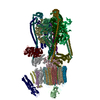 9brqC 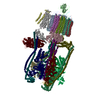 9brrC 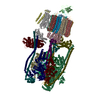 9brsC 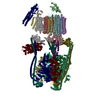 9brtC 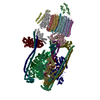 9bruC 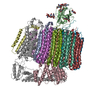 9bryC 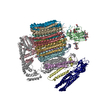 9brzC M: map data used to model this data C: citing same article ( |
|---|---|
| Similar structure data | Similarity search - Function & homology  F&H Search F&H Search |
- Links
Links
- Assembly
Assembly
| Deposited unit | 
|
|---|---|
| 1 |
|
- Components
Components
-V-type proton ATPase ... , 14 types, 30 molecules 89QRTV01234567UXabdghijklmnoce
| #1: Protein | Mass: 26196.449 Da / Num. of mol.: 3 / Source method: isolated from a natural source / Details: VATE1_MOUSE V-type proton ATPase subunit E 1 / Source: (natural)  #2: Protein | Mass: 13674.476 Da / Num. of mol.: 3 / Source method: isolated from a natural source / Details: VATG2_MOUSE V-type proton ATPase subunit G 2 / Source: (natural)  #3: Protein | Mass: 68402.875 Da / Num. of mol.: 3 / Source method: isolated from a natural source Details: VATA_MOUSE V-type proton ATPase catalytic subunit A Source: (natural)  References: UniProt: P50516, H+-transporting two-sector ATPase #4: Protein | Mass: 56611.570 Da / Num. of mol.: 3 / Source method: isolated from a natural source / Details: VATB2_MOUSE V-type proton ATPase subunit B / Source: (natural)  #5: Protein | | Mass: 43945.449 Da / Num. of mol.: 1 / Source method: isolated from a natural source / Details: VATC1_MOUSE V-type proton ATPase subunit C 1 / Source: (natural)  #6: Protein | | Mass: 28419.117 Da / Num. of mol.: 1 / Source method: isolated from a natural source / Details: VATD_MOUSE V-type proton ATPase subunit D / Source: (natural)  #7: Protein | | Mass: 55922.859 Da / Num. of mol.: 1 / Source method: isolated from a natural source / Details: VATH_MOUSE V-type proton ATPase subunit H / Source: (natural)  #8: Protein | | Mass: 13389.262 Da / Num. of mol.: 1 / Source method: isolated from a natural source / Details: VATF_MOUSE V-type proton ATPase subunit F / Source: (natural)  #9: Protein | | Mass: 96442.500 Da / Num. of mol.: 1 / Source method: isolated from a natural source Details: VPP1_MOUSE V-type proton ATPase 116 kDa subunit a isoform 1 Source: (natural)  #10: Protein | | Mass: 21618.553 Da / Num. of mol.: 1 / Source method: isolated from a natural source Details: VATO_MOUSE V-type proton ATPase 21 kDa proteolipid subunit Source: (natural)  #11: Protein | | Mass: 40341.934 Da / Num. of mol.: 1 / Source method: isolated from a natural source / Details: VA0D1_MOUSE V-type proton ATPase subunit d 1 / Source: (natural)  #12: Protein | Mass: 15815.833 Da / Num. of mol.: 9 / Source method: isolated from a natural source Details: VATL_MOUSE V-type proton ATPase 16 kDa proteolipid subunit Source: (natural)  #14: Protein | | Mass: 51046.215 Da / Num. of mol.: 1 / Source method: isolated from a natural source / Details: VAS1_MOUSE V-type proton ATPase subunit S1 / Source: (natural)  #17: Protein | | Mass: 9203.020 Da / Num. of mol.: 1 / Source method: isolated from a natural source / Details: VA0E2_MOUSE V-type proton ATPase subunit e 2 / Source: (natural)  |
|---|
-Protein , 3 types, 3 molecules pfs
| #13: Protein | Mass: 39128.789 Da / Num. of mol.: 1 / Source method: isolated from a natural source / Details: RENR_MOUSE Renin receptor / Source: (natural)  |
|---|---|
| #15: Protein | Mass: 11000.004 Da / Num. of mol.: 1 / Source method: isolated from a natural source / Details: RNK_MOUSE Ribonuclease kappa / Source: (natural)  References: UniProt: Q8K3C0, Hydrolases; Acting on ester bonds |
| #16: Protein | Mass: 34045.406 Da / Num. of mol.: 1 / Source method: isolated from a natural source / Details: SYPH_MOUSE Synaptophysin / Source: (natural)  |
-Experimental details
-Experiment
| Experiment | Method: ELECTRON MICROSCOPY |
|---|---|
| EM experiment | Aggregation state: CELL / 3D reconstruction method: single particle reconstruction |
- Sample preparation
Sample preparation
| Component | Name: Mouse brain isolated glutamatergic synaptic vesicles / Type: ORGANELLE OR CELLULAR COMPONENT / Entity ID: all / Source: NATURAL |
|---|---|
| Molecular weight | Experimental value: NO |
| Source (natural) | Organism:  |
| Buffer solution | pH: 7.4 |
| Specimen | Embedding applied: NO / Shadowing applied: NO / Staining applied: NO / Vitrification applied: YES Details: The specimen state should be an intact subcellular component. |
| Vitrification | Cryogen name: ETHANE |
- Electron microscopy imaging
Electron microscopy imaging
| Experimental equipment |  Model: Titan Krios / Image courtesy: FEI Company |
|---|---|
| Microscopy | Model: TFS KRIOS |
| Electron gun | Electron source:  FIELD EMISSION GUN / Accelerating voltage: 300 kV / Illumination mode: FLOOD BEAM FIELD EMISSION GUN / Accelerating voltage: 300 kV / Illumination mode: FLOOD BEAM |
| Electron lens | Mode: BRIGHT FIELD / Nominal defocus max: 4000 nm / Nominal defocus min: 1000 nm |
| Image recording | Electron dose: 50 e/Å2 / Film or detector model: GATAN K3 BIOQUANTUM (6k x 4k) |
- Processing
Processing
| Software | Name: PHENIX / Version: 1.21_5207: / Classification: refinement | |||||||||
|---|---|---|---|---|---|---|---|---|---|---|
| EM software |
| |||||||||
| CTF correction | Type: PHASE FLIPPING AND AMPLITUDE CORRECTION | |||||||||
| 3D reconstruction | Resolution: 4.3 Å / Resolution method: FSC 0.143 CUT-OFF / Num. of particles: 25667 / Symmetry type: POINT | |||||||||
| Atomic model building | Protocol: FLEXIBLE FIT |
 Movie
Movie Controller
Controller















 PDBj
PDBj